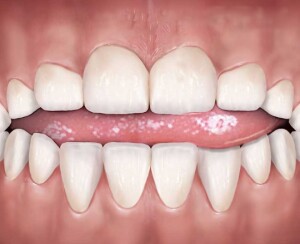There are several other potential causes for tongue thrust that begin in infancy. Some of these include:
- Long-term sucking habits that influence the tongue’s movement, like sucking of the thumb, fingers, or tongue
- Allergies accompanied by chronically swollen tonsils or adenoids
- Tongue-tie, where the band of tissue beneath the tongue is tight or short
- A swallowing pattern known as reverse swallow
Tongue thrust has a number of telltale signs that manifest in children who have developed the pattern. These can include:
- Tongue is visible between the teeth. The tip of the tongue sticks out between the teeth, whether the child is resting, swallowing, or speaking.
- Mouth breathing.
- Inability to close the lips completely. This could be due to a structural abnormality or habit.
- Open bite. This occurs when the front teeth don’t meet when the teeth are closed.
- Slow, fast, or messy eating.
- Speech impediment. Lisping of s and z sounds is common.
Treatment of Tongue thurst
Tongue thrust often corrects with time or at the age of 8-9 years. Self-correction is due to musculature Balance during swelling.
- Orthodontic treatment can be carried out.
- Speech therapy is indicated.
- If an associated habit is present like thumb sucking than it must be treated first.
- Training the tongue for correct swallow & posture.
- Use of appliances to correct position of tongue.
- Correction of Malocclusion.




